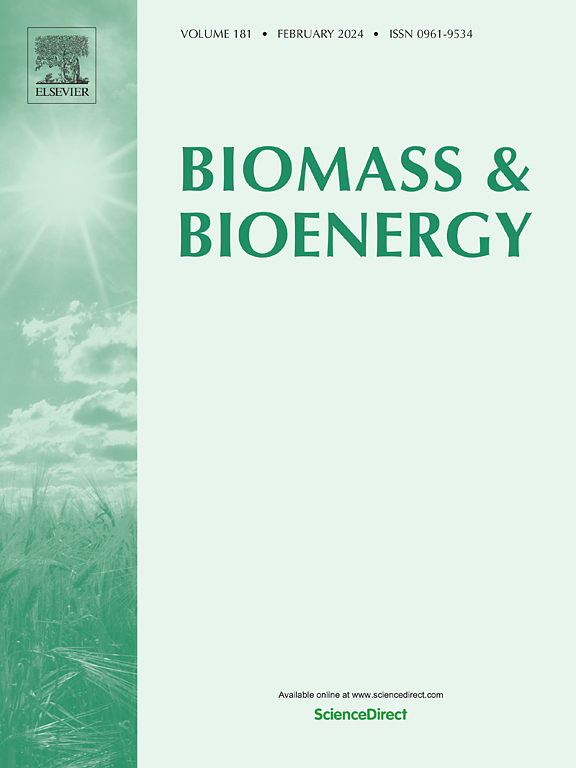Improved bioethanol production from corn stover using microwave-assisted protic ionic liquid pretreatment and an engineered S. cerevisiae strain
IF 5.8
2区 生物学
Q1 AGRICULTURAL ENGINEERING
引用次数: 0
Abstract
Construction of a green, economical, and energy-efficient lignocellulose pretreatment process is the core to improve the economic feasibility of the second-generation bioethanol production. This study presents an effective strategy for bioethanol production based on microwave-assisted Diisopropylammonium hydrosulfate ([DIP][HSO4]) pretreatment. The mechanisms for the depolymerization of the lignocellulose matrix in the novel pretreatment process were proposed by characterize the fractionated pulp and lignin. In this process, the effect of microwave power on mono-sugars production was also investigated. Results indicated that substantial removal of hemicellulose and lignin by 63.75 wt% and 59.36 wt %, respectively, were realized at 170 W for 3 min, which afforded to 69.69 % and 73.78 % of glucan and xylan recoveries in subsequent saccharification. Ethanol fermentation performances of the enzymatic hydrolysate of the pretreated pulps were evaluated using a C5/C6 co-assimilation Saccharomyces cerevisiae YL23. 34.35 g L−1 of ethanol with a yield of 0.42 g g−1 (total monomer sugars in hydrolysate) was received in the end fermentation broth using the fed-batch hydrolysate containing total 80.88 g L−1 of mono-sugars. Correspondingly, 12.01 g of bioethanol and 13.12 g of technical lignin were co-generated from 100 g of dried corn stover.

利用微波辅助原生离子液体预处理和改造的 S. cerevisiae 菌株提高玉米秸秆的生物乙醇产量
构建绿色、经济、节能的木质纤维素预处理工艺是提高第二代生物乙醇生产经济可行性的核心。本研究提出了一种基于微波辅助二异丙基硫酸氢铵([DIP][HSO4])预处理的生物乙醇生产的有效策略。通过分析分馏纸浆和木质素的特征,提出了新型预处理工艺中木质纤维素基质的解聚机理。在此过程中,还研究了微波功率对单糖生产的影响。结果表明,在 170 W、3 分钟的条件下,半纤维素和木质素的去除率分别达到 63.75% 和 59.36%,在随后的糖化过程中,葡聚糖和木聚糖的回收率分别达到 69.69% 和 73.78%。使用 C5/C6 协同同化酿酒酵母 YL23 评估了预处理纸浆酶水解物的乙醇发酵性能。使用含单糖总量为 80.88 g L-1 的进料批次水解物,在最终发酵液中获得了 34.35 g L-1 的乙醇,乙醇产量为 0.42 g g-1(水解物中的单体糖总量)。相应地,100 克干燥玉米秸秆可产生 12.01 克生物乙醇和 13.12 克工业木质素。
本文章由计算机程序翻译,如有差异,请以英文原文为准。
求助全文
约1分钟内获得全文
求助全文
来源期刊

Biomass & Bioenergy
工程技术-能源与燃料
CiteScore
11.50
自引率
3.30%
发文量
258
审稿时长
60 days
期刊介绍:
Biomass & Bioenergy is an international journal publishing original research papers and short communications, review articles and case studies on biological resources, chemical and biological processes, and biomass products for new renewable sources of energy and materials.
The scope of the journal extends to the environmental, management and economic aspects of biomass and bioenergy.
Key areas covered by the journal:
• Biomass: sources, energy crop production processes, genetic improvements, composition. Please note that research on these biomass subjects must be linked directly to bioenergy generation.
• Biological Residues: residues/rests from agricultural production, forestry and plantations (palm, sugar etc), processing industries, and municipal sources (MSW). Papers on the use of biomass residues through innovative processes/technological novelty and/or consideration of feedstock/system sustainability (or unsustainability) are welcomed. However waste treatment processes and pollution control or mitigation which are only tangentially related to bioenergy are not in the scope of the journal, as they are more suited to publications in the environmental arena. Papers that describe conventional waste streams (ie well described in existing literature) that do not empirically address ''new'' added value from the process are not suitable for submission to the journal.
• Bioenergy Processes: fermentations, thermochemical conversions, liquid and gaseous fuels, and petrochemical substitutes
• Bioenergy Utilization: direct combustion, gasification, electricity production, chemical processes, and by-product remediation
• Biomass and the Environment: carbon cycle, the net energy efficiency of bioenergy systems, assessment of sustainability, and biodiversity issues.
 求助内容:
求助内容: 应助结果提醒方式:
应助结果提醒方式:


